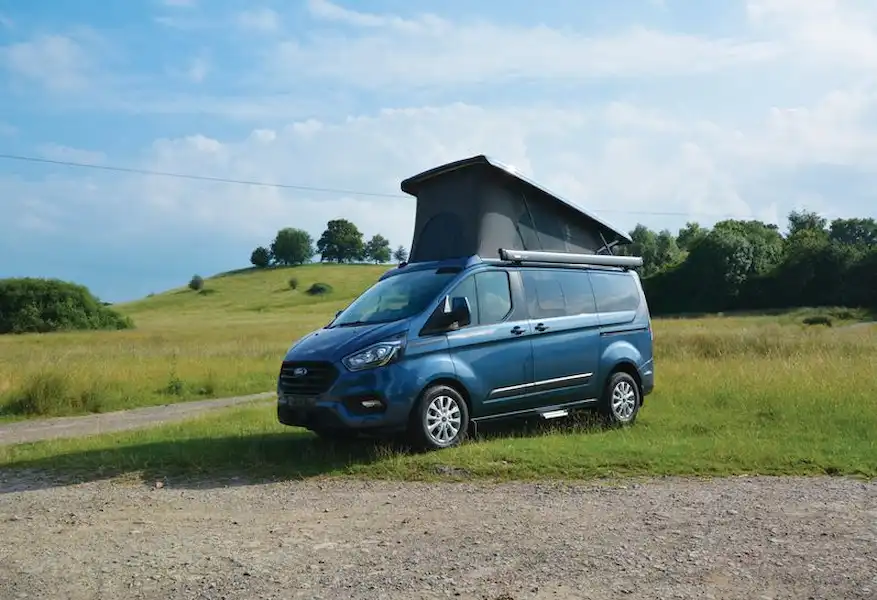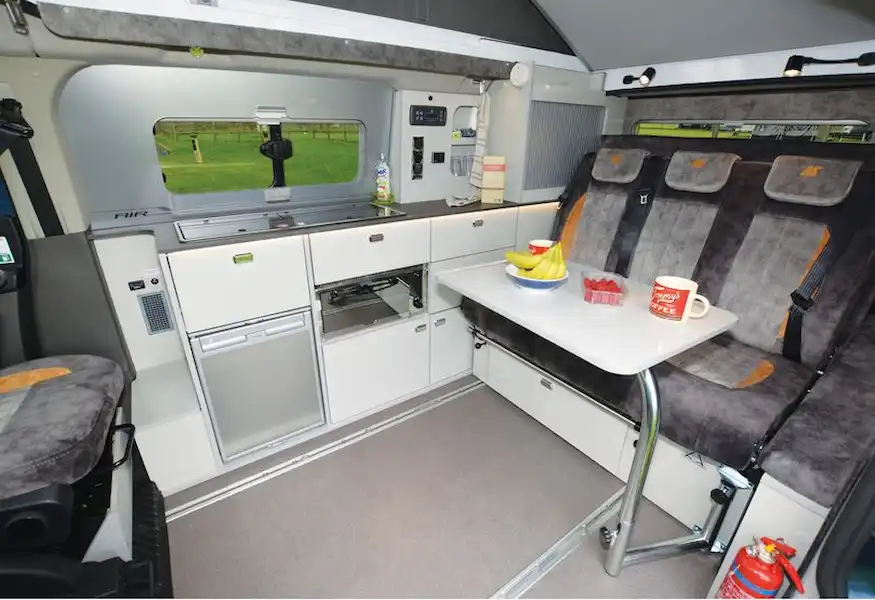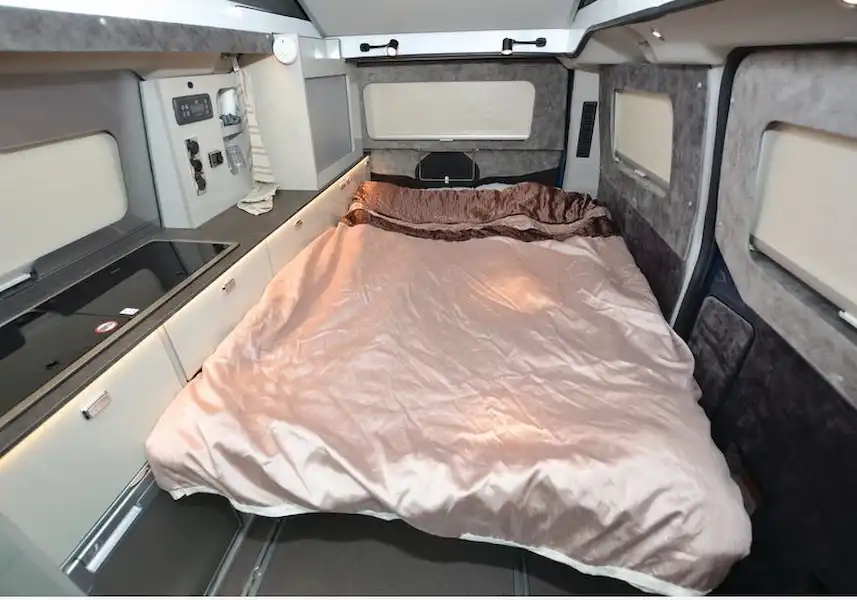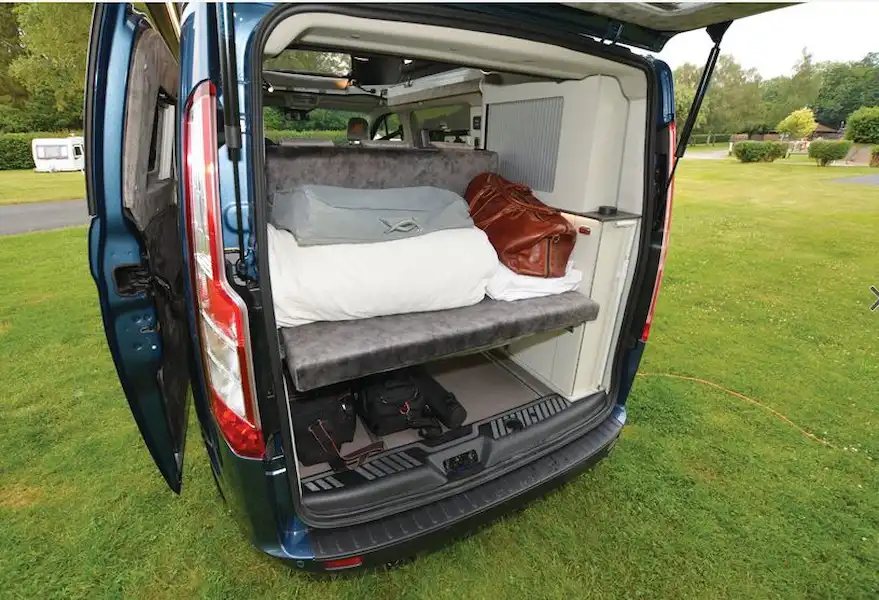Key Features
| Model Year | 2022 |
| Class | Rising Roof |
| Base Vehicle | Ford Transit Custom |
| Price From (£) | 66,995 |
| Length (m) | 4.97 |
| Berths | 4 |
| Belted Seats | 5 |
| Main Layout | Campervan |
At a glance
Full review
Words and photos: Peter Vaughan
Auto-Sleeper Air
The very first Auto-Sleepers all had elevating roofs and such models dominated the company’s output through the 70s, before high-tops took over in the late 80s. Still the Cotswold company persisted with pop-tops, though, until the Volkswagen T5 Trooper bowed out in 2012. It hasn’t offered a classic side-kitchen layout campervan since.
Auto-Sleepers hadn’t forgotten its roots, however, and, after burning its fingers with the short-lived Mercedes Wave, a Peugeot-based camper oh-so-nearly made it into the showrooms four years ago, but for homologation issues. Then, when I collected the new Broadway EL coachbuilt for a road test earlier this year, I was excited to see a Ford Transit Custom campervan taking shape in the R&D area. The new model has now been christened Air, with sales initially only through Marquis outlets, beginning in January.
Auto-Sleepers sees the Air sitting at the top of the camper tree, competing with OEM models such as Ford’s own Nugget, the Mercedes Marco Polo and, of course, the best-selling VW California. The only major options will be a choice of manual or automatic gearbox (the latter at a £1,500 premium), and a selection of metallic paint finishes (blue, red, orange or silver). The £1,500 Executive Pack will be a default option, so every Air will have it – not that you’d want to miss out, as it adds £3,084-worth of Ford goodies over and above the already well-equipped Trend version of the Transit Custom.
Of course, the Air will also have European Whole Vehicle Type Approval and Auto-Sleepers is aiming to achieve Ford’s QVM standard, too.
Keep it clean
Auto-Sleepers has resisted the temptation to plaster the exterior with motorhome-style graphics and the few ‘Air’ motifs it has applied are classily restrained. The company has even avoided adding obvious service points – the mains hook-up is underneath on the offside, alongside the water tank drains, and the fresh water filler is in the step well, just inside the driver’s door. With privacy glass and modest 16in alloy wheels, the overall look is one of a high-end people-carrier.
Of course, its size – at just under 5m long – makes the Air just as at home in the office car park or on the school run, although the Ford is too tall for 2m height barriers. Where it may surprise is on the motorway – standard fitment of the 168bhp (170PS) engine makes this an extremely lively performer.
If this is your first camper – or even if you’re coming from a VW T6.1 – you will not be disappointed with any aspect of the drive, although the Volkswagen perhaps just has the edge with the smoothness of its DSG automatic transmission.
The blue oval beats the torque of the Transporter, though, with 390Nm (compared with 340Nm of the 148bhp VW), making the steep climbs of the Malvern Hills disappear with just a squeeze of the throttle. The ride is
comfortable, rattles are few and the Custom just feels like a big, tall car.
You won’t feel short-changed on spec, either. The sat-nav cleverly rerouted me around an overturned lorry and the 8in touchscreen display was just as effective when it became the reversing screen as I backed up to my pitch marker on the Malvern Caravan and Motorhome Club site.
It even comes with a lithium leisure battery as standard, as well as a roll-out Thule awning, a 60W solar panel and, most unusually in this size of campervan, a 15-litre underslung gas tank (which frees up space inside).
You get front and rear parking sensors, too (useful as through-view is restricted by the back seat), and myriad safety features, such as lane departure warning, blind spot assistance, adaptive cruise control and traffic sign recognition. Automatic lights and wipers, cornering lights, a heated windscreen, electric folding mirrors, front fog lights, a leather steering wheel and lumbar adjustment on the driver’s seat are all included, too, while heated cab seats are the icing on this jam-laden Victoria sponge.
Pop up the pop-top
Continuing the top-notch theme, Auto-Sleepers is fitting the Air with a German SCA roof, which is as good as they come. I rather like its belt and braces approach, with two catches on either side to release before a firm push sees interior headroom go from 1.41m to well over 2m. Two zipped half-moon flyscreens (front and nearside) and a window (offside) provide plenty of daylight and ventilation, but it isn’t the type where the whole canvas unzips.
It does have a press-studded headlining above the cab seats when the roof is down, though, to keep things looking neat. And its star feature is a 1.89m by 1.10m upstairs mattress sitting on Clima Plux springs for excellent sleeping comfort.
We applaud the fact that Auto-Sleepers has turned to Germany for the Air’s seat system, too. The Reimo Variotech unit used here has three seatbelts, a trio of height-adjustable head restraints and Isofix mountings for a pair of child seats.
Better still, of course, it is fully type approved and slides along its bonded-in rail system, which allows kids to travel much closer to the cab and the boot area’s volume to grow exponentially. It’s a very comfortable seat, too – without the dangling leg issues that affect so many RIB seat installations – while the soft-touch upholstery is so tactile you might find yourself subconsciously stroking it!
The extra interior width of the Ford (versus VW) also means that a three-seater bench can be installed without compromising the size of the kitchen alongside.
Toast at most
Unlike the one-of-a-kind Ford Nugget, Auto-Sleepers hasn’t tried to reinvent the wheel with the Air’s interior and has stuck with the tried-and-trusted approach of a side kitchen layout, completed with a taller wardrobe unit in the rear corner.
Both cab seats swivel easily, without recourse to opening the doors. The handbrake does have to be released to turn the driver’s chair, but it’s worth the effort because there’s a good-sized gap between it and the galley.
The kitchen has the expected combination two-burner hob and sink unit in stainless steel with split glass lids, as well as a front-loading 47-litre compressor fridge. More of a surprise is the separate grill – you still won’t be cooking a Sunday roast, but toast is back on the menu.
The gloss-finish cabinets look contemporary (and nothing like other Auto-Sleepers), while the two-tone appearance is actually down to the way the light catches the furniture. Storage includes a cutlery holder above the grill, a shallow cupboard under the sink and a deep locker – which housed my pots and pans, plates, cups, etc, – alongside the back seat. Above here is a useful area of worktop adjacent to two USBs and a 230V socket, as well as a shelved recess that held my glasses.
Inspector Gadget would love this camper as there are more USBs in the base of the handbrake, under the passenger cab seat and in a pop-up unit by the head of the bed. There’s also a novel bottle opener mounted on the wall above the sink, but no over-window top lockers as seen in some rival designs.
What really impresses is the interior lighting. Reading lights are fitted to serve both front seats, as well as over the rear bench (ideal in bed, too) and there are two spotlights above the side door. A long LED strip illuminates the galley, while under-counter downlights add a hint of bling.
Tabling a motion
As part of the Reimo seat system, the table leg bracket is attached to the base of the bench, so it moves fore and aft with the seat. The leg then just slots in and the tabletop screws to it, creating a sturdy surface for either dining or typing. The table storage is being moved from beneath the back seat on this prototype to a much more convenient home in the boot, where this example had a second, free-standing table that will be deleted from production models.
A bigger concern is access to some of the storage. The wardrobe has a false floor to separate the space below if you don’t need to hang clothes – very sensible, but the useful additional cupboard created needs a sliding door (like the wardrobe), so you can get to it without moving the seat.
Some of the floor-level cupboards are also rather awkward to reach, especially the one containing the charger and habitation area fuses. Remember, too, to ensure that all the cupboard catches are in the locked position before sliding the seat – otherwise they get snapped off!
Of course, to maximise storage, the best position for the back seat when camping is where it parks for bedmaking, thus also creating a generous boot area. I’ve often said that this space is the key to a successful campervan design and the Air boasts plenty of room here for bedding above the mattress, and loads more space for everything from wellies to outdoor chairs underneath.
On the prototype, the cold water outside shower became inaccessible with the bed down but this has now been modified at MMM’s suggestion. What hasn’t changed is where the rear seat blocks the cupboard for the loo (under the grill) when in ‘camping mode’, so you’re probably best to keep the toilet in the boot instead.
Otherwise, you’ll need to remember to move the seat and extract the Dometic toilet from its home (where there’s room for loo roll and chemical, too) before you make the bed.
Long good night
When it comes to shut-eye, you’ll find pull-down blinds (and flyscreens) on the side and rear windows, rather than fabric curtains.
Low-level ventilation is rather restricted, though, because there are only small hinged sections in the side glazing – no full sliding panes for those hot summer nights. But, in cooler climes, you’ll appreciate the standard-fit Webasto diesel-fired blown-air heater with its outlet under the front passenger seat.
In the cab, insulated screens stick to the glass with suckers, but these are quite bulky to store and Auto-Sleepers is changing suppliers as the ones tested were of poor quality.
To make the main bed, you simply flip over the base of the rear bench and then lift a lever to allow the backrest to fold forward. In two ticks your bed is made – and it’s completely flat and very comfy. Not only that, but the mattress is a very generous length, at almost 2m, and a good width (1.32m – better than in most VWs), where an infill alongside the seat extends the bed over the nearside wheelarch.
And, of course, if you already had the back seat in the mid position, with the rear mattress section folded down, then you can simply unfurl your duvet from the boot and slide yourself in.
A half-leather seating option will be available, priced at £1,295, but you’ll still be sleeping on cloth surfaces as the Reimo bed system is such that you sleep on the reverse (flat) side, not the contoured seat.
Motorhome supplied by Auto-Sleepers
Tel: 01386 853338
auto-sleepers.com
Insurance: £506
Tel: 0800 975 1307
shieldtotalinsurance.co.uk
For quote details: motorhome.ma/QuoteInfo
Videos
Expert motorhome advice to your door!
Why not subscribe to one of our fabulous magazines and get expert advice, travel ideas, technical help and all the latest news for your motorhome and your motorhome adventures!
Want to know more about MMM magazine?
Every month MMM has articles written by motorhomers who have been there and done it, from great UK and European (and further afield) tours, campsite reviews, owners' reports and DIY projects among other things. MMM's tests, reviews and expert buying guides are not to be missed. MMM's technical advice is a must and includes everything from weekend jobs to longer-term DIY projects. And much more!
About MMM magazineWant to know more about What Motorhome magazine?
Every issue of What Motorhome magazine provides essential buying advice for anyone looking to buy a new motorhome or campervan or upgrade their existing model. With a pedigree of over 30 years of offering the best motorhome and campervan buying advice, every issue of What Motorhome includes more new motorhome and campervan reviews than you will find in any other magazine.
About What MotorhomeWant to know more about Campervan magazine?
Campervan is the exciting monthly magazine that will give you all the inspiration you need to explore the world in your campervan. Every issue is packed with real-life campervanning experiences, inspiring travel ideas in the UK and further afield, the best campsites to stay on, campervan road tests and reviews of the latest models, and much more!
About Campervan magazine
















